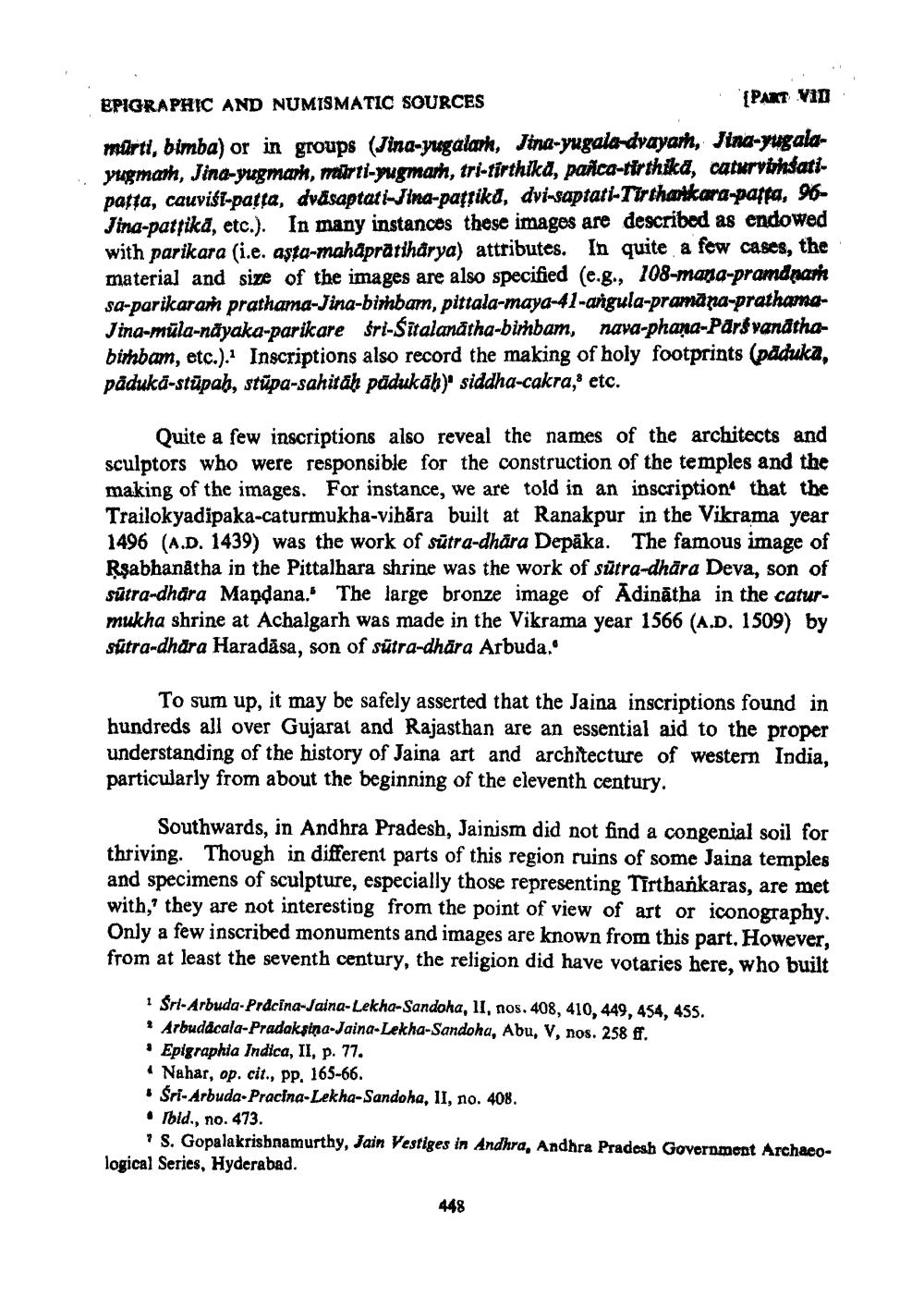________________
EPIGRAPHIC AND NUMISMATIC SOURCES
(PART VID
mürti, bimba) or in groups (Jina-yugalark, Jina-yugala-dvayarh, Jina-yugalayugman, Jina-yugmarh, mirti-yugmarh, tri-tirthika, panca-tirthika, caturythsaripatta, cauvisi-patta, dvasaptatl-Jina-patrikd, dvi-saptati-Tirtharkara-parfa, 96Jina-patrika, etc.). In many instances these images are described as endowed with parikara (i.e. asta-mahaprātiharya) attributes. In quite a few cases, the material and size of the images are also specified (e.g., 108-mana-pramdnan sa-parikaram prathama-Jina-bimbam, pittala-maya-41-angula-pramāna-prathamaJina-müla-nayaka-parikare Sri-Sitalanåtha-birbam, nava-phana-Parsvandthabimbam, etc.). Inscriptions also record the making of holy footprints (paduka, păduka-stūpah, stūpa-sahitah pädukāb) siddha-cakra, etc.
Quite a few inscriptions also reveal the names of the architects and sculptors who were responsible for the construction of the temples and the making of the images. For instance, we are told in an inscription that the Trailokyadipaka-caturmukha-vihåra built at Ranakpur in the Vikrama year 1496 (A.D. 1439) was the work of sūtra-dhära Depāka. The famous image of Rşabhanåtha in the Pittalhara shrine was the work of sūtra-dhāra Deva, son of sūtra-dhara Mandana. The large bronze image of Adinātha in the caturmukha shrine at Achalgarh was made in the Vikrama year 1566 (A.D. 1509) by sutra-dhara Haradāsa, son of sütra-dhāra Arbuda.
To sum up, it may be safely asserted that the Jaina inscriptions found in hundreds all over Gujarat and Rajasthan are an essential aid to the proper understanding of the history of Jaina art and architecture of western India, particularly from about the beginning of the eleventh century.
Southwards, in Andhra Pradesh, Jainism did not find a congenial soil for thriving. Though in different parts of this region ruins of some Jaina temples and specimens of sculpture, especially those representing Tirtbankaras, are met with, they are not interesting from the point of view of art or iconography. Only a few inscribed monuments and images are known from this part. However, from at least the seventh century, the religion did have votaries here, who built
1 Sri-Arbuda-Prdcina-Jaina-Lekha-Sandoha, II, nos. 408, 410, 449, 454, 455. . Arbuddcala-Pradaksina-Jaina-Lekha-Sandoha, Abu, V, nos. 258 ff.
Epigraphia Indica, II, p. 77. • Nahar, op. cit., pp. 165-66.
Śri-Arbuda-Pracina-Lekha-Sandoha, II, no. 408. • Told., no. 473.
* S. Gopalakrishnamurthy, Jain Vestiges in Andhra, Andhra Pradesh Government Archaeological Series, Hyderabad.
448




